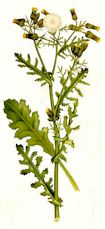|

Groundsel |
Common Groundsel is so well known throughout Great Britain, that it needs scarcely any description. It is very prolific, and found in every sort of cultivated ground, being a small plant of the Daisy tribe, but without any outer white rays to its yellow flower-heads. These are compact little bundles, at first of a dull yellow color, until presently the florets fall off and leave the white woolly pappus of the seeds collected together, somewhat resembling the hoary hairs of
age. They have suggested the name of the genus "senecio," from the Latin senex, an old man:--
"Quod canis simili videatur flore capillis; Cura facit canos quamvis vir non habet annos."
"With venerable locks the Groundsel grows; Hard care more quick than years white head-gear shows."
|
In the fifteenth century this herb went by the name of Grondeswyle, from grund, ground, and swelgun, to swallow, and to this day it is called in Scotland Grundy Swallow, or Ground Glutton.
Not being attractive to insects or visited by them the Groundsel is fertilized by the wind. It flowers throughout the whole year, and is the favorite food of many small birds, being thus given to canaries, and to other domesticated songsters.
The weed, named at first "Ascension," is called in the Eastern counties by corruption "Senshon" and "Simson." Its leaves are fleshy, with a bitter saline taste, whilst the juice is slightly acrid, but emollient. In this country farriers give it to horses for bot-worms, and in Germany it is employed as a vermifuge for children. A weak infusion of the whole plant with boiling water makes a simple and easy purgative dose, but a strong infusion will act as an emetic. For the
former purpose two drachms by weight of the fresh plant should be boiled in four fluid ounces of water, and the same decoction serves as a useful gargle for a sore throat from catarrh. Chemically it contains senecin and seniocine.
In the hands of Simplers the Groundsel formerly held high rank as a herb of power. Au old herbal prescribes against toothache to "dig up Groundsel with a tool that hath no iron in it, and touch the tooth five times with the plant, then spit thrice after each touch, and the cure will be complete." Hill says "the fresh roots if smelled when first taken out of the ground, are an immediate cure for many forms of headache." To apply the bruised leaves will serve for preventing
boils, and the plant, if taken as a sallet with vinegar, is good for sadness of the heart. Gerard says "Women troubled with the mother (womb) are much eased by baths made of the leaves, and flowers of this, and the kindred Ragworts."
A decoction of Groundsel serves as a famous application for healing chapped hands. In Cornwall if the herb is to be used as an emetic they strip it upwards, if for a purgative downwards. "Lay by your learned receipts," writes Culpeper, "this herb alone shall do the deed for you in all hot diseases, first safely, second speedily."
Herb Simples
The Primitive Simplers presented here show the way of life in other generations, it is not suggested or recommended trying them yourself. |
|
Garden
Herbs
Home
History of Herbs
Herb Gardening
Herbs for Beginners
Drying & Preserving Herbs
Indoor Herb Gardening
Herb Garden
Hints & Tips
Herbal
Cooking
Herb Chart
Using Herbs
Culinary Herbs
Herb
Oil and Vinegar
Herb Teas
Herb Candy
Herb Jelly
Herb Simples
Preface
Introduction
Alphabetical Listing

Trade
Recipes Online
Share your Recipes with others!!
|


